Pricing of Electricity by Country » (Updated July 2024)

Our world is a pretty big and diverse place, but there is one thing that connects us with most other countries – using electricity to power our appliances, heat or cool our homes and keep the lights on. In 2017, the world’s electricity consumption amounted to approximately 22.3 trillion kilowatt-hours – more than three times the amount consumed in 1980.
However, there are huge differences in how electricity is generated, used, and even how much it costs in different parts of the world. For example, Iceland as the only developed nation generates its electricity from 100% renewable energy sources while China’s electricity comes almost exclusively from fossil fuels. Egyptians spend only about 2 cents per kilowatt-hour of electricity, while Danish households a whopping 34 cents, nearly 17 times more.
Today, we will analyze electricity prices around the world and the unique combination of factors that influence them, then attempt to answer the question most probably on your mind – how does the United States compare?
Global Average Electricity Price
If we averaged out the electricity prices in every country in the world, we would arrive at 14.2 U.S. cents per kWh for household users and 12.7 U.S. cents per kWh for business users – the global average electricity price. The average U.S. electricity prices are 0.7 cents and 1.7 cents respectively lower – which means that our power is a tiny bit cheaper than the world’s average. Of course, this average electric price is composed of countries with a lot higher and a lot lower average price. Let us look at where electricity is the most expensive and the cheapest.
Countries With Most Expensive Electricity Prices
| Ranking | Country | Avg Electric Price (in U.S. cents per kWh) |
|---|---|---|
| 1 | Germany | 39 |
| 2 | Bermuda | 37 |
| 3 | Denmark | 34 |
| 4 | Portugal | 32 |
| 5 | Belgium | 32 |
| 6 | Cayman Islands | 31 |
| 7 | Bahamas | 31 |
| 8 | Cape Verde | 30 |
| 9 | Ireland | 29 |
| 10 | Japan | 29 |
| 11 | Cyprus | 28 |
| 12 | Barbados | 28 |
| 13 | United Kingdom | 27 |
| 14 | Italy | 27 |
| 15 | Liechtenstein | 27 |
| 16 | Australia | 26 |
| 17 | Luxemburg | 26 |
| 18 | Rwanda | 26 |
| 19 | Austria | 25 |
| 20 | Jamaica | 25 |
Dataset: globalpetrolprices.com
Germany and Bermuda hold the unpopular title of countries with the most expensive electricity for very different reasons. In Germany, a complex web of politically determined taxes, levies, and surcharges make up nearly half of the price that residential customers pay and as a result, German electricity prices more than doubled over the past twenty years.
Bermuda must import most of its electricity in the form of cooking gas, car gasoline, and oil, making them susceptible to high import duties. As a tiny island of mere 21 square miles, any attempt at producing electricity at home results too expensive with no economies of scale possible.
Countries With the Least Expensive Electricity Prices
| Ranking | Country | Avg Electric Price (in U.S. cents per kWh) |
|---|---|---|
| 1 | Sudan | 0 |
| 2 | Venezuela | 0 |
| 3 | Iran | 0 |
| 4 | Ethiopia | 1 |
| 5 | Kyrgyzstan | 1 |
| 6 | Cuba | 1 |
| 7 | Libya | 1 |
| 8 | Zimbabwe | 1 |
| 9 | Bhutan | 2 |
| 10 | Angola | 2 |
| 11 | Suriname | 2 |
| 12 | Uzbekistan | 3 |
| 13 | Zambia | 3 |
| 14 | Iraq | 3 |
| 15 | Kuwait | 3 |
| 16 | Qatar | 3 |
| 17 | Oman | 3 |
| 18 | Algeria | 4 |
| 19 | Egypt | 4 |
| 20 | Kazakhstan | 4 |
Dataset: globalpetrolprices.com
You probably spotted a few well-known oil producers in the table with the cheapest electricity countries, most notably Venezuela, Iran, Iraq, Kuwait, and Qatar. Thanks to the great crude oil reserves and the status of energy exporters, these countries benefit from massive economies of scale, allowing them to enjoy some of the cheapest electricity prices in the world.
That of course raises the question of whether such low prices, resulting from the overreliance on non-renewable, dirty sources like oil are a positive thing and what is their long-term consequence for the world.
Percentage Of Day’s Wages Needed To Buy Electricity
Of course, looking at only the electric price around the world won’t tell us much. Households in every country earn different wages so 15 cents per kilowatt-hour can be cheap for some, while very expensive for others.
Purchasing power parity (PPP) is used to ensures a like-for-like comparison for buying goods and services by adjusting the data for average wages and the exchange rate. Let’s look at the portion of your daily wages needed to buy a day’s worth of electricity around the world.
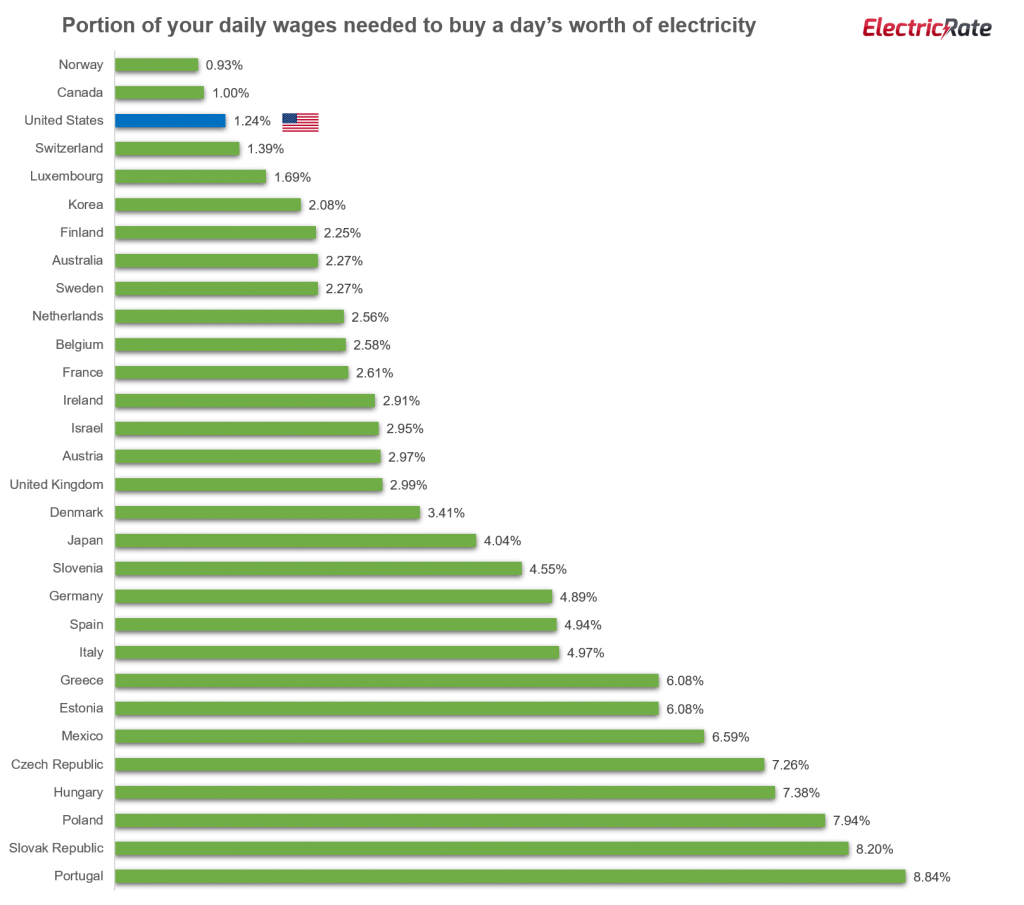
In the U.S., residents only need to use about 1.24% of their daily wages to consume power throughout the day. Affordability is a bigger challenge in European nations. Households in Portugal, Slovak Republic, Poland, Hungary, and the Czech Republic need to spend up to 8% of their wages.
And while the average electric prices in Germany are the highest in the world, the average electric bills account for only about 5% of their residents’ wages – thanks to higher average annual salary levels.
How Do Countries Generate Electricity?
Globally, 36.7% of our electricity was low carbon in 2019, such as solar, wind, hydropower, and nuclear. Just over one-third. That leaves the remaining two-thirds to come from non-renewable sources or fossil fuels.
Non-renewable energy comes from resources that are not replenished and therefore their supply on this earth is limited. Petroleum, for example, was formed millions of years ago from the remains of ancient sea plants and animals. Other fossil fuels are coal, petroleum, natural gas, propane, and uranium. These sources account for the majority of the world’s greenhouse gas emissions.
Some countries around the world have managed to transition towards low-carbon electricity sources, while others remind heavily dependent on fossil fuels.
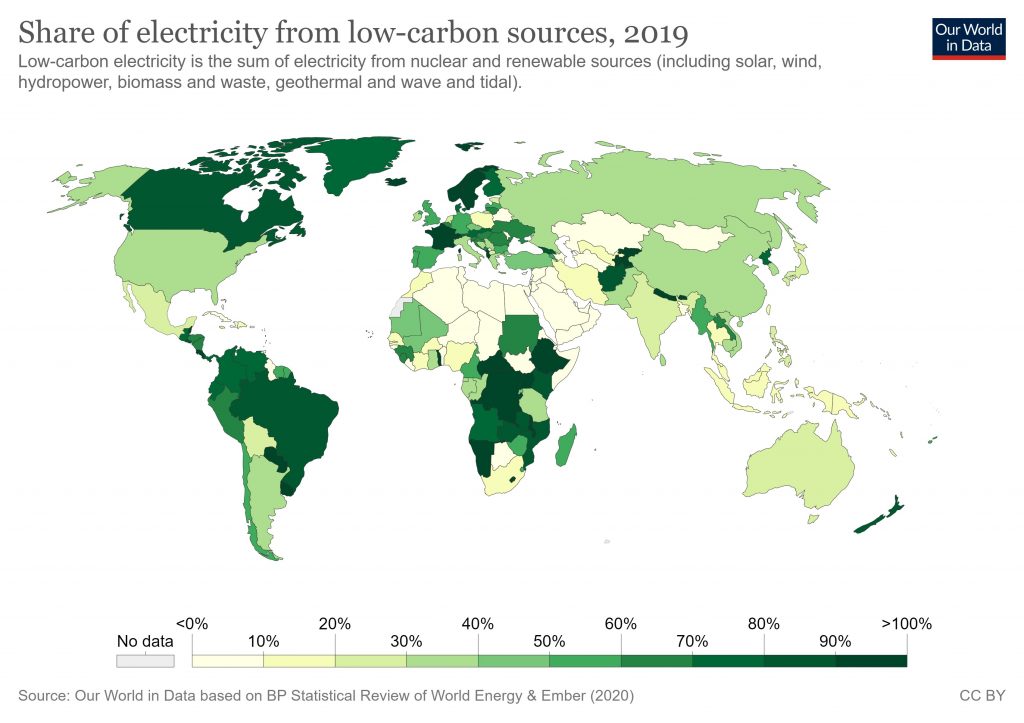
The right meteorological conditions make ideal candidates for green energy use. Canada, the Northern U.S. neighbor, generates more than 67% of its electricity from renewable sources, thanks to hydroelectric systems, spreading coast to coast. Another 15% comes from nuclear energy (also a low-carbon source), making Canadian electricity almost entirely renewable.
Another example, this time from the European shores is Norway. The Nordic country produces 98% of its energy from renewable sources, thanks to its abundant glaciers, fjords, and strong winds.
On the other hand, some countries face what’s called a ‘resource curse’ – an abundance of natural reserves of fossil fuels, making it hard to transition towards clean energy. In the Middle East and Northern Africa, it is the presence of vast oil fields, in Australia it’s coal. These uneven conditions aggravate global climate change, as they remove the incentives for some parts of the world to invest in clean, renewable technology.
How Do U.S. Electricity Prices Compare With the Rest of the World?
Now that we covered the electricity basics around the world, you are probably wondering – how does the USA compare? Is our electricity expensive, compared to other countries? Do we generate more or less renewable power than, let’s say, Mexico? How much electricity do we use?
They say that a picture says a thousand words, so let’s look at electric rates in the U.S. using simple infographics.
Starting with average electric rates, the U.S. households pay on average 14 cents per kilowatt-hour of electricity. That might seem like a lot and of course, you might find a lot cheaper rate when you switch electric suppliers, but try to tell a fellow German or a Japanese what you pay for electricity and they might offer you a hearty congratulations – the electricity in those countries costs more than double!
On the other hand, families in Canada, Mexico, or Egypt would find our electricity expensive. Cuban households would find it mad – the average electric rate there is only 1 cent.
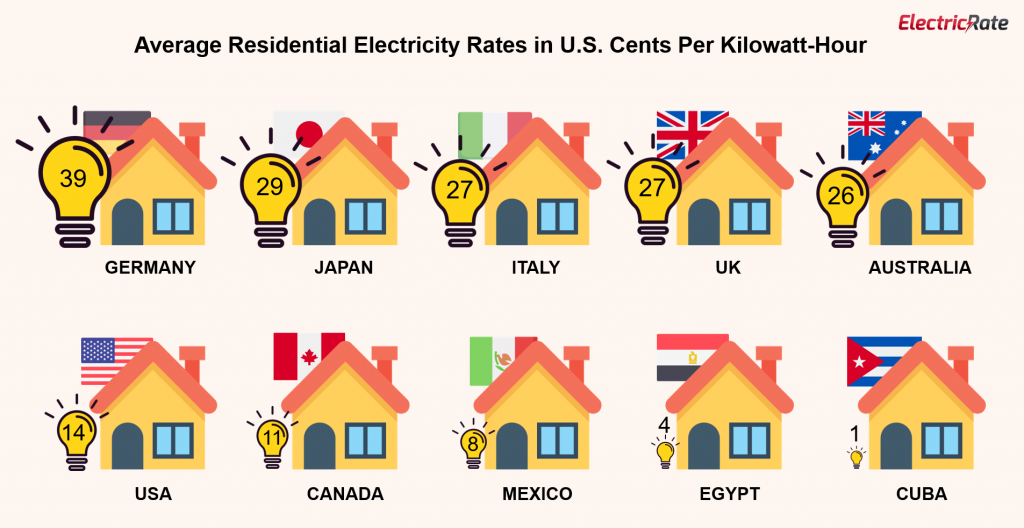
Of course, the size of your electric bills will also depend on how much electricity your household uses on regular basis. Due to the growing population and increasing electrification in our homes (think of all the appliances in your house that need to be plugged in), the global residential electricity usage is going up – the EIA projects a nearly 50% increase in world energy usage by 2050.
The USA leads the way in terms of household electric usage in the world – an average US household consumes approximately 975 kilowatt-hours of electricity each month, three times more than for example the United Kingdom.
Our European counterparts Germany and Italy consume even less, 277 and 220 kilowatt-hours retrospectively. Given the average electric prices in these countries (the above picture), this is probably just as well – otherwise, their monthly bills would be astronomically high!
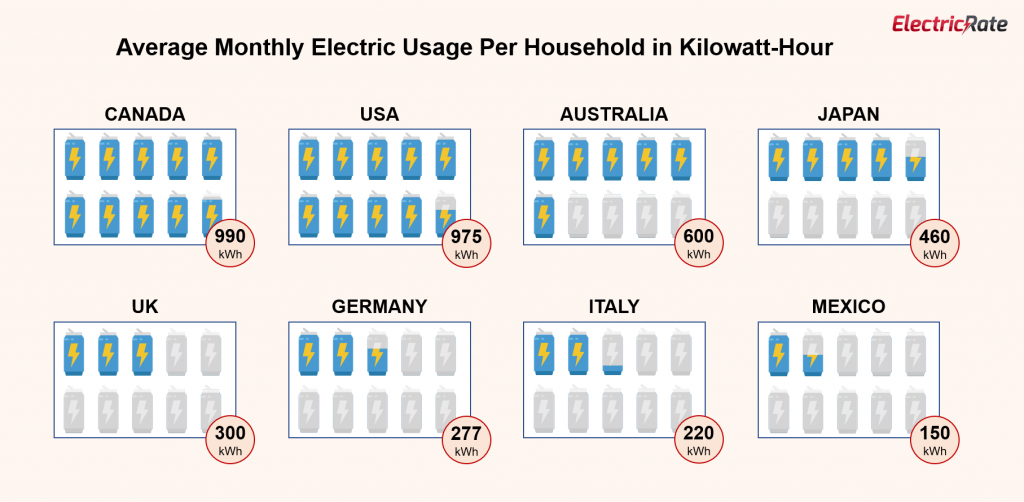
Finally, we look at how electricity is generated. Despite all efforts, the world continues being heavily addicted to fossil fuels, which are responsible for most of the emissions. Growing electric consumption is particularly a problem if the electricity comes from carbon-intensive sources. Most of the developed world produces electricity made predominately from fossil fuels. One notable exception is Canada, whose hydroelectric systems enable reliance on the world’s oldest renewable source – water.
The U.S. has long produced electricity from coal, but in 2017 it was overtaken by natural gas, which now accounts for 34% of the country’s generation. However, the share of renewable energy is slowly, but steadily going up. Since 2008, U.S. installations have grown to an estimated 62.5 gigawatts (GW), or enough to power 12 million average American homes.
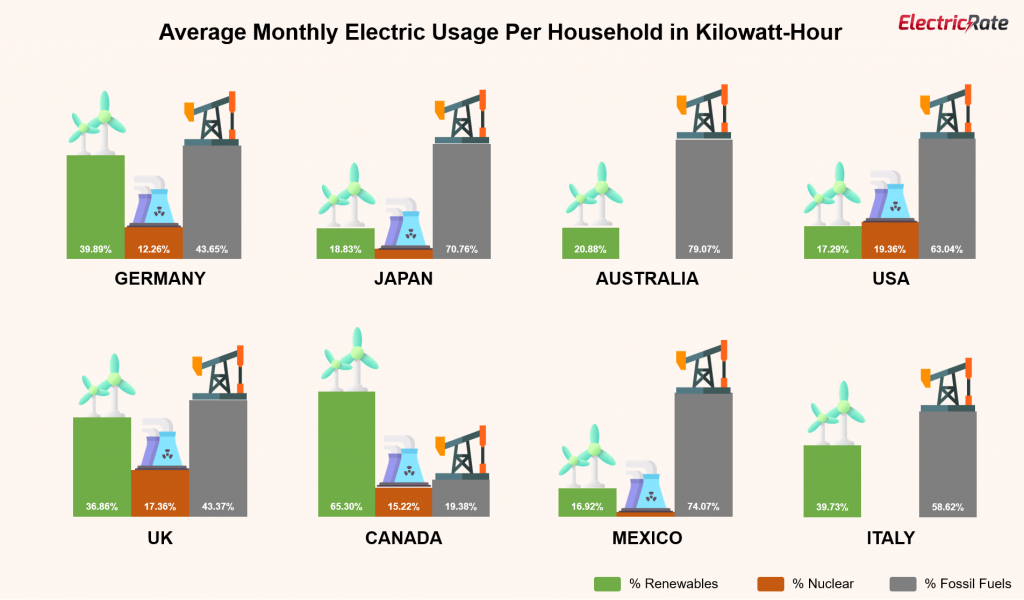
How Many People Don’t Have Access To Electricity?
While we talk about the average electric prices in different countries, it is important to recognize that some parts of the world still do not have access to electricity at all, particularly in the African continent. According to the scientific publication Our World in Data (OWID), some 13% of the world did not have access to electricity in 2016 even if the accessibility has been steadily growing.
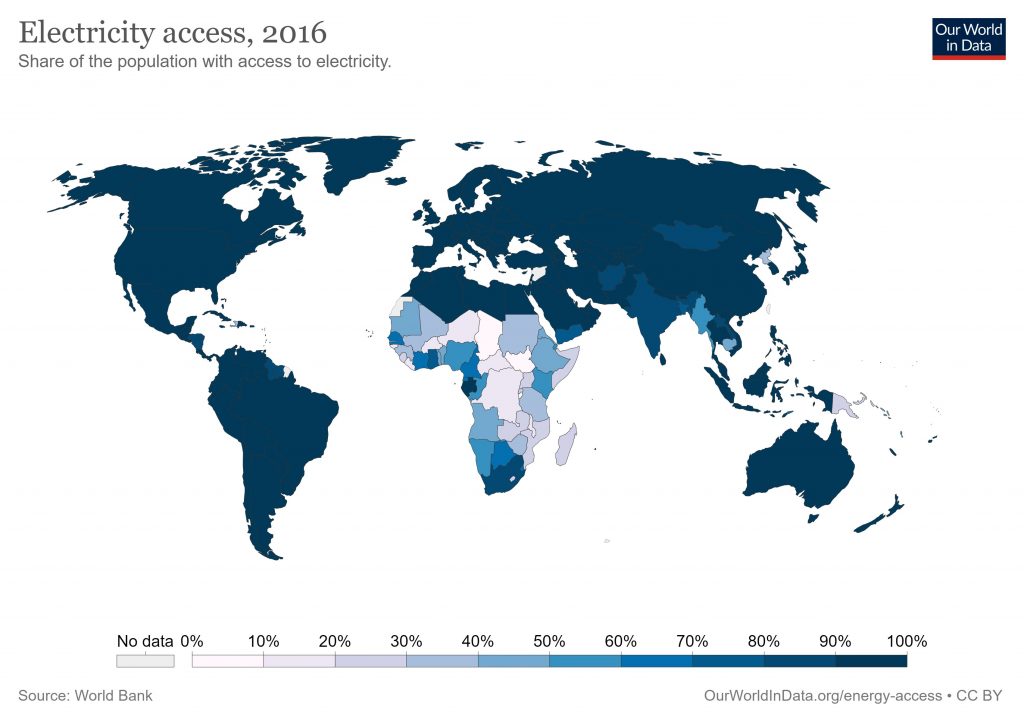
If you think that the electricity in the U.S. is expensive, you now know that there are countries that have it much worse (but also much better). Of course, electric prices are relative to people’s average wages – while Germans have the highest average electric price in the world (nearly triple the U.S. price!), they need to use less than 5% of their daily wages to pay for it.
However, low electricity prices are not always a good thing – in many countries, they represent large quantities of cheap fossil fuels that continue to pollute our planet. Finally, as we ponder electricity and all its wonders, it’s important to remember that there are still people in the world without access to electricity (approximately 13%), so we shouldn’t take it for granted.
Updated on
